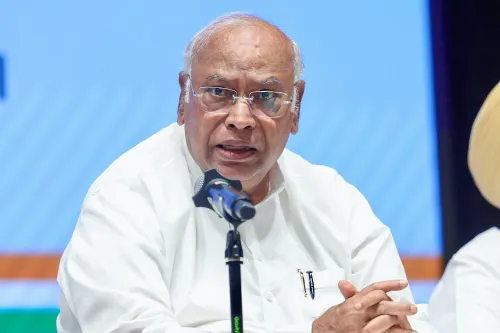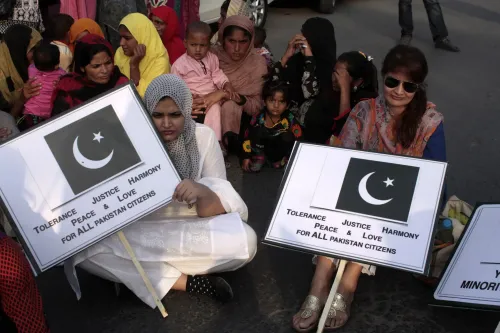How is ‘Militant Bangladesh’ on the Rise? (IANS Analysis)

Synopsis
Key Takeaways
- TTP's resurgence is linked to the Taliban's takeover in Afghanistan.
- Bangladeshi nationals are increasingly joining the TTP.
- Islamist groups are regaining strength in Bangladesh.
- Political changes may exacerbate security risks.
- International cooperation is vital for counterterrorism.
New Delhi, Oct 16 (NationPress) Pakistan's geopolitical landscape appears to have come full circle, plagued by the ongoing terror of Tehrik-e-Taliban Pakistan (TTP).
Established in 2007, the TTP is a jihadist militant group primarily focused on targeting the Pakistani military. This extremist organization aims to establish an Islamic caliphate aligned with the Deobandi tradition within Pakistan.
Moreover, the TTP has provided support to the Taliban's activities in Afghanistan. Although banned in 2008, the TTP is suspected of maintaining strong connections with al-Qaeda and the Taliban, with its militant actions predominantly concentrated in Pakistan's Federally Administered Tribal Areas (FATA) and Khyber Pakhtunkhwa, which border Afghanistan.
Since the Taliban's takeover in Afghanistan in 2021, the TTP has resumed operations, leading to a rise in attacks that contribute to Pakistan's internal terror issues. Additionally, Pakistan's state-sponsored terror factions continue to engage in cross-border terrorism, particularly against India.
A recent military operation in Khyber Pakhtunkhwa resulted in the death of 17 TTP militants, revealing a startling finding: one of the deceased militants was identified as a Bangladeshi national.
Reports from Bangladeshi media indicate that the family of the slain militant was unaware of his militant past, claiming he had relocated to Dubai for work. However, police intelligence suggests that he had actually moved to Afghanistan.
Pakistani officials have noted the capture of two or three Bangladeshi militants in previous operations, who allegedly traveled to Afghanistan under the guise of religious duties, subsequently joining an extremist terrorist organization.
This incident is not isolated. In April, a 23-year-old Bangladeshi named Ahmed Zubair, identified as a TTP member, was among 54 militants killed by the Pakistani military. Reports also indicate that at least eight Bangladeshi nationals have migrated to Afghanistan to align with the TTP.
Bangladesh's digital media has highlighted that the country's own security intelligence remains unaware of the TTP's outreach within its borders and whether any camps currently operate there. Additionally, two individuals—33-year-old Ahmed Faisal and 49-year-old Shamin Mahfuz—were apprehended in Bangladesh in July for suspected ties to the TTP.
It is noteworthy that Mahfuz is a former leader of Jamaat-ul-Mujahedeen Bangladesh (JMB), who later established the Jama'atul Ansar Fil Hindal Sharqiya in 2019. Both individuals were previously detained on multiple terrorism-related charges.
Faisal's confession revealed that many Bangladeshi militants have traveled to Afghanistan either via Saudi Arabia or through Pakistan to join the TTP.
Predominantly comprising youth, these militants aspire to create an Islamic caliphate globally, adhering to Sharia law. During this arrest, it was disclosed that four Bangladeshi nationals who joined the TTP were killed along the Afghan-Pakistan border, with 25 more reportedly preparing to depart Bangladesh for jihad.
The confession also brought to light one Imran Haider, a senior TTP figure, identified as a pivotal player in the online indoctrination of Bangladeshi youth for TTP recruitment.
Simultaneously, 36 Bangladeshi nationals were reportedly detained in Malaysia for their alleged participation in a “radical militant movement”. However, Bangladesh's home advisor dismissed these claims, denying any extremist affiliations.
Since last year, South Asian geopolitics has taken an unpredictable turn with the downfall of Sheikh Hasina in Bangladesh following the July Uprising.
On one hand, the interim government in Bangladesh has strengthened ties with Pakistan, enhancing bilateral relations—including in trade, education, defense, and intelligence sharing—while keeping a deliberate distance from India, its long-standing regional ally.
Conversely, Bangladesh has experienced a rapid rise of Islamist groups, previously suppressed by the Awami League government's counterterrorism efforts. Transnational extremist organizations like Hizb-ut Tahrir (banned in 2009) have reasserted their presence, notably for allegedly orchestrating a student procession in Dhaka under the banner of ‘Conscious Teachers and Students’, demanding the establishment of an Islamic Caliphate in Bangladesh last October, along with the ‘March to Khilafat’ rally this March.
Muhammad Yunus has also appointed individuals linked to Hizb-ut Tahrir in his interim government, stirring controversy within the political arena.
Moreover, leaders and affiliates of groups such as Hefazat-e-Islam, Ansarulla Bangla Team, and Khelafat Majlis—arrested for their extremist connections—were released under the interim government, subsequently resuming their hate propaganda to push for an Islamic state in Bangladesh governed by Sharia law.
These developments raise alarms regarding the resurgence of Islamist extremism in Bangladesh, given its historical context. Individuals from Bangladesh previously joined the Taliban to combat the Soviet Union in Afghanistan, returning to establish extremist organizations like Harkat-ul Jihad Al Islami Bangladesh (HuJIB) and Jamaat-ul-Mujahedeen Bangladesh (JMB) in the late 1980s and 1990s.
It is important to acknowledge that these groups not only shared ideological ties with the Taliban but also received logistical backing and training from al-Qaeda and the Pakistan-based Lashkar-e-Taiba (LeT), with the aim of fostering a Taliban-like regime in Bangladesh.
Despite counterterrorism measures crippling their operations by 2007, Bangladesh has continued to endure sporadic terror attacks, witnessing a surge between 2013 and 2016.
The recent political transformations in Bangladesh following Hasina's removal further exacerbate concerns regarding the return of Islamist extremism in the country, as evidenced by the aforementioned reports.
The recent visit of seven Islamic clerics, including the Khelafat Majlis chief and Nayeb-e-Amir (Pir of Madhupur) of Hefazat-e-Islam, to Afghanistan at the Taliban's invitation should be approached with caution, reflecting the rising trend of militancy in Bangladesh. These groups share the same ideological foundation—the Deobandi school of Islam—as the Taliban and celebrated the Taliban’s takeover of Afghanistan as a “victory for Islam”.
While these parties may not be extremist themselves, their ideological affinity with the Taliban and their hardline perspectives on socio-cultural and political matters suggest a potential convergence of interests between these organizations and foreign-affiliated militant groups.
Nevertheless, the additional inspector general of Bangladesh's Anti-Terrorism Unit asserts that no militant activity is currently present in Bangladesh, while simultaneously acknowledging that future militant operations cannot be entirely dismissed.
With elections approaching and Bangladesh's democracy in a precarious state, the resurgence of militancy now presents a significant security threat, not just to Dhaka but to South Asia as a whole. One can only hope that Bangladesh's law enforcement agencies tackle militant trends earnestly, without resorting to denial. Otherwise, Bangladesh could soon find itself in a situation akin to Pakistan.









